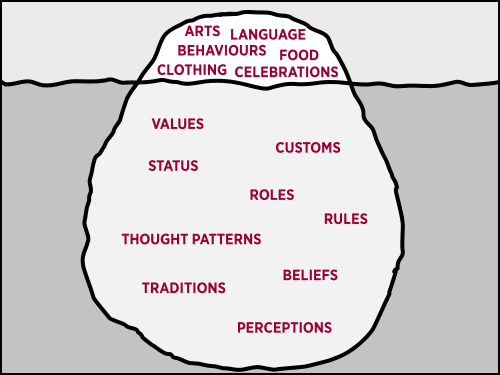Culture is often described as an iceberg. Above water are the most obvious aspects of culture. Below the water are those aspects which are more intrinsic and understood only by the carriers of the given culture. The importance of cultural awareness (“cultural literacy”) is actual while dealing with the study of any language. The language competence never narrows down to the study of grammatical patterns and basic vocabulary items. It is far beyond this formal part of language learning. To be a competent and confident speaker, the students must be quite well aware of the culture-specific traits of people who speak the given foreign language. E. D. Hirsch defines “cultural literacy” as the ability to understand and participate fluently in a given culture. So the role of “cultural literacy” is very important in EFL classroom.

The main aspects of cultural literacy instruction may include:
- Informing the learners on the target language habits and customs, geography, history, social and political conditions of L2 country;
- Encouraging the learners to reflect over the main cultural differences between their own culture and the culture of L2 country;
- Informing learners on the L2 literature, arts, music;
- Informing the learners on values and attitudes of L2 speakers;
- Developing learners’ tolerance and openness and cultures.
In order to cover these points during the lesson the teacher may use these techniques:
- Students are asked to compare any aspect of their own culture with the L2 culture;
- Students are involved in some role-plays in which people from different cultures meet;
- Different videos or audio materials are used to illustrate this or that aspect of culture;
- Students are asked what it would be like to live in the given foreign culture;
- A teacher may talk about some stereotypes of L2 culture;
- A classroom may be decorated with some posters or other visuals illustrating aspects typical of the given culture;
- The teacher may bring some objects originating from the L2 culture;
- Some aspects of the foreign culture which arouse negative connotations are presented by the teacher;
- If the teacher has the chance, he or she may invite a guest speaker from L2 country to the classroom.
Practical Tips and Ideas for “Cultural Literacy” Lessons
- Food is a wide topic which can arouse the learners’ interest and teach them a lot of culture-specific things. The teacher may bring any reading or audio/video material on some eating habits and traditions of the L2 country. Students discuss the material, compare the information with the eating habits in their country. They may work in groups and classify similar and different habits. As a wrap-up activity, they may form a daily or weekly diet scheme including popular dishes from their culture and L2 culture.
- Sport is also topic which can be discussed by drawing parallels between the L1 and L2 cultures. Two popular sports may be compared with each other in terms of their popularity around the world, rules, history, etc. Students may have in-classroom video sessions of those games and reflect back on the main information they have learnt. More enthusiastic groups may play those games outside and have great fun.
- Films/Paintings are the aspects of culture which give plenty of food for thought and can be used in a number of ways in the lesson. They are great visual stimuli and provide learners with useful information. They may create classroom exhibitions of the most famous paintings or organize film-watching sessions.
- Behavioural Aspects are reflected in some cultural peculiarities about the beliefs or daily behaviour that people have. For instance, in England, people value private distance a lot. The teacher may give a list of this kind of features and ask the learners to compare with their culture. They may approve or disapprove of some of the behavioural aspects that the cultures under study have by grounding their opinions.
- Superstitions/stereotypes always a source of fun and useful information. A teacher may give the students a list of true/false superstitions and stereotypes and the learners need to guess which of them are typical of the given culture.
You can make use of resources here, here and here while developing your lessons within the framework of cultural literacy. Being a culturally literate instructor and developing those skills in EFL learners will add a lot of value to the learning process.






 Вероника Аветисян
Вероника Аветисян 
 Маргарита Аветисян
Маргарита Аветисян 



This author should be prohibited to write articles in English because her level is not up to scratch for that. Constant grammatical and lexical mistakes, no sense of language, inappropriate use of lexis to name just a few. It’s really sad and shameful that your overhyped company that pumps so much money into marketing, doesn’t have the resources to proofread the articles they send to thousands of people, most of whom, mind you, are teachers.
Dear Svetlana,
Thank you for your feedback. We will take into consideration all your comments and will try to take an approach that guarantees high quality of the material.